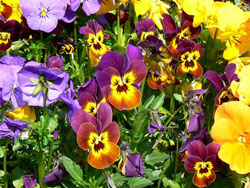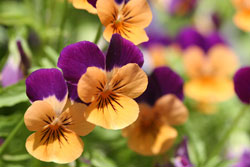Pansies (Viola x wittrockiana) are small, short-lived perennials for chilly fall to spring bloom. Once planted in the garden, pansies may reappear for several years because they self-sow. When the weather warms in late spring, pansies begin to fade because they have a low tolerance for hot weather.
Researchers around the world are working to introduce pansies with novel color combinations, larger flower size and better tolerance to weather conditions.
Pansies have one of the widest color ranges of any garden annual; blooms range from red, purple, blue, bronze, pink, yellow, black, lavender, white, orange and burgundy. Pansies are often known as the “face flower” and a single bloom may have up to three colors mixed in the delicate flower.
Two pansies recommended for Colorado gardens by Plant Select are Blue Velvet®. a deep purple flower with a black face that’s hardy from Zones 2-9 and up to 11,000 feet; and Northern Lights™, a large-flowered pansy with mixed bloom colors of lilac, blue and cream.

Strictly speaking, sweet violets, bedding violas, and pansies are all classified as “violas.” Sweet violets are descended from the European wild sweet violet, v. odorata; bedding violas (the flower that we usually call “violas”) were hybridized from pansies and v. cornuta. Pansies developed from the wild violas v. lutea and v. tricolor (“johnny-jump-up”). Sixty species are native to the U.S. and about 100 varieties are offered for sale.
Pansies are versatile and can be planted in garden beds or containers for seasonal color. Plant in amended, well-drained soil where they can receive morning sun.
For more information, see the following Planttalk Colorado™ video(s).
For more information about pansies, see the following Colorado State University Extension resource(s):



